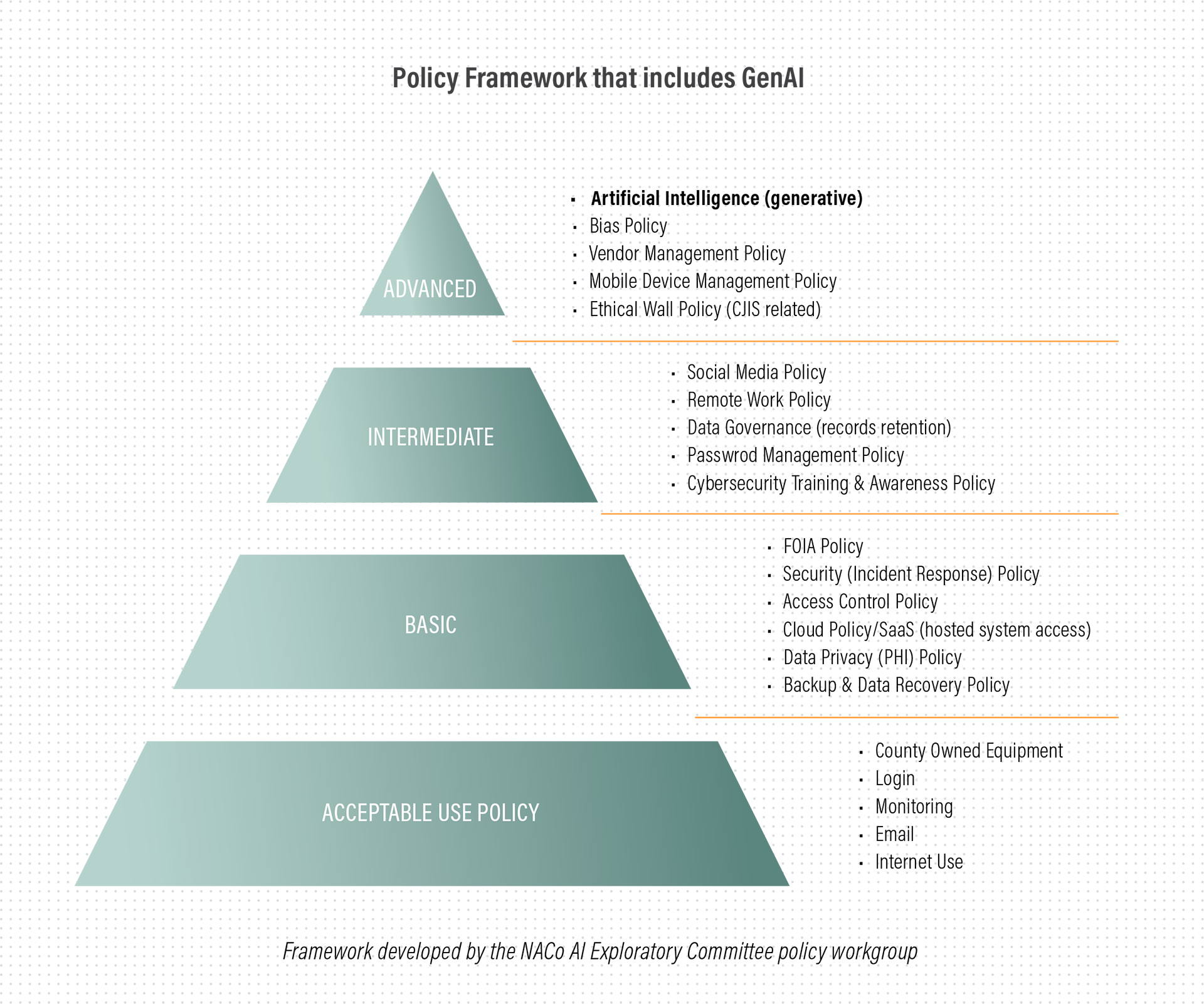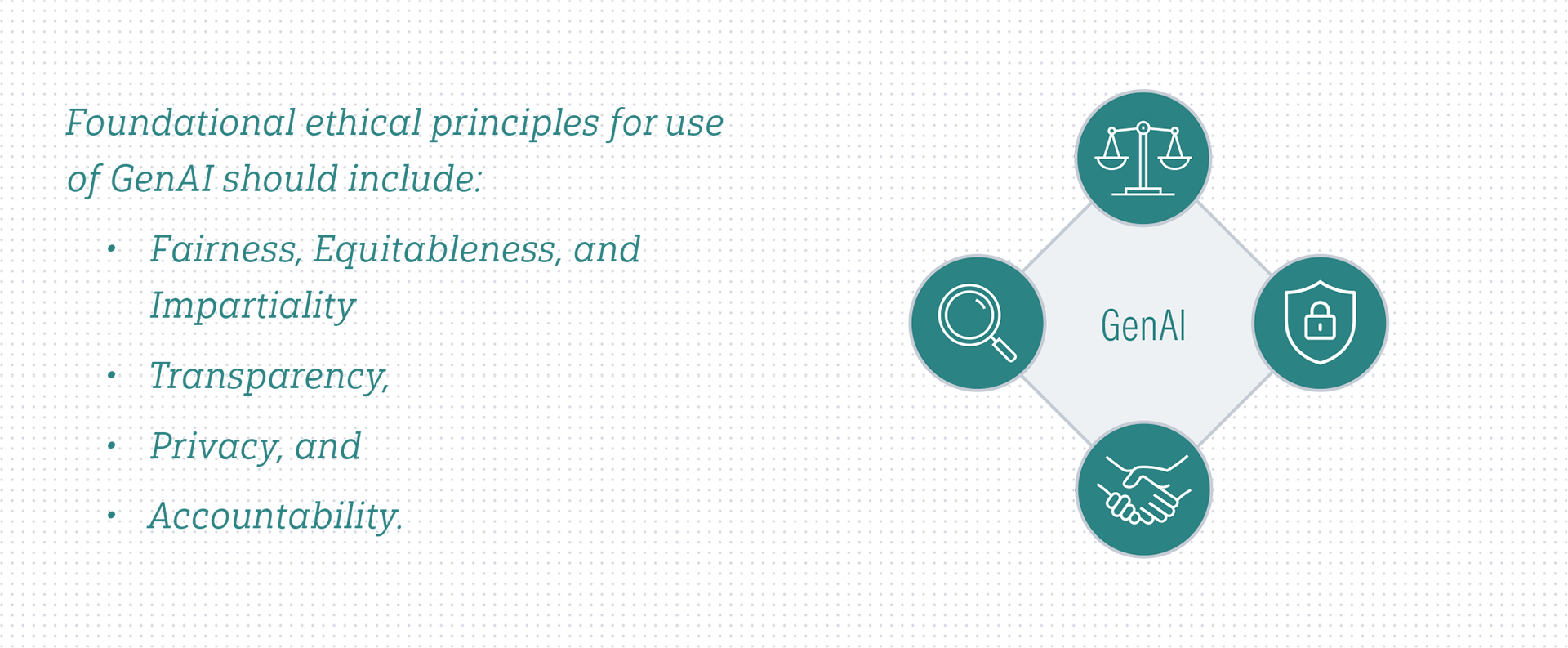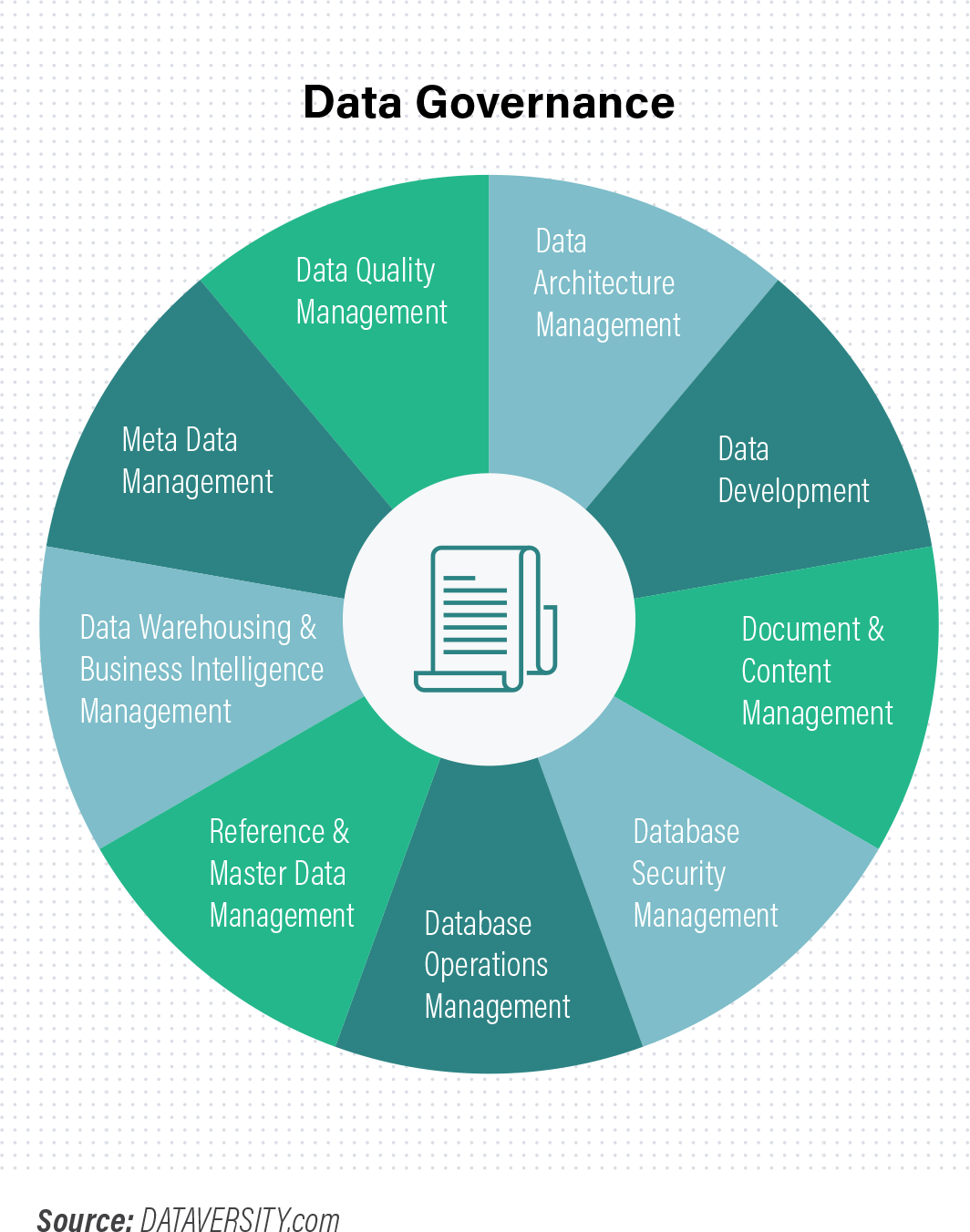AI County Compass: A Comprehensive Toolkit for Local Governance and Implementation of Artificial Intelligence

Upcoming Events
Related News
The NACo AI Compass and Resource Hub provides county governments with essential tools and knowledge to navigate the complexities of generative artificial intelligence (GenAI). Developed by NACo's AI Exploratory Committee, this toolkit covers key themes such as responsible applications, policy models, ethical frameworks, and workforce preparation, helping counties leverage GenAI for improved operations and services.
Customize Your Compass
The Artificial Intelligence (AI) Exploratory Committee was formed in May 2023 and tasked with analyzing the landscape of generative AI as it applies to counties.
Use the links below to download the AI Exploratory Committee’s full report or jump to key sections of the report. In the navigation above, find an impact summary for your county role, as well as report highlights customized for you.
Jump to Section
County Elected Officials
While the full report is available for county officials, an approach that focuses on the landscape analysis and recommendations developed by the four working groups is recommended as a starting point for county elected officials.
Key Sections of the Compass
County CIOs, IT Directors and IT Staff
This toolkit for county IT leaders is a valuable resource and includes areas on the myths, definitions, and detailed recommendations developed by the four working groups, as well as various templates and county use cases.
It is recommended that County CIOs, IT directors and IT staff also read the report in its entirety – click here to download.
Jump to Section
County Administrative Staff
It is recommended that county administrative staff focus on reviewing the landscape analysis, summarized recommendations, sample county governance policies and county use cases.
Key Sections of the Compass
Letter Content

Hon. Andy Brown

Hon. Gregg Weiss
Dear Reader,
The genie is out of the bottle.
Over the past two years, we have witnessed the rise of an innovative new technology poised to transform our economy and society: generative artificial intelligence. The advent of generative artificial intelligence is bringing vast new opportunities in computing power and capability that will alter how society utilizes technology for the public good.
Perhaps a more significant leap than the dawn of the internet, generative artificial intelligence is laying the groundwork for how companies, organizations, and governments will operate in the future with great speed. Building on artificial intelligence, which is not new, the generative technology offers the ability to produce text, audio, and video in a novel way, as well as support vastly increased productivity.
In light of this moment, we face an unprecedented challenge—and ultimately, a significant opportunity—to frame the rise of generative artificial intelligence in a way that will promote its responsible enablement and not endanger humanity's rights or roles. This challenge is mirrored by a few other moments in the history of technological progress.
Four key themes emerged during our committee’s year-long exploration of generative artificial intelligence: Preparing the Workforce, Establishing an Ethical Framework, Promoting Policy Models, and Enabling Responsible Applications. Each theme prompted our committee to study the impact of generative artificial intelligence deeply, specifically through the lens of county governance.
The goal of this report and toolkit is to enable county government to recognize low-risk versus high-risk implementations of artificial intelligence and generative artificial intelligence and address the challenges that both bring to local government. This report represents the cumulative discussions and contributions of various county leaders across the country – from all geographies, stripes, and perspectives – and we hope it will provide you with a framework for approaching generative artificial intelligence. You will also find more in-depth information and valuable resources on the NACo.org website.
Let’s go where no one has gone before!
Sincerely,
Co-Chair Gregg Weiss, Commissioner, Palm Beach County, Fla.
Co-Chair Andy Brown, County Judge, Travis County, Texas
The Rise of Artificial Intelligence
The advent of generative artificial intelligence (GenAI) worldwide presents unique opportunities and challenges for county governments. NACo has convened an Artificial Intelligence Exploratory Committee, whose goal is to develop a knowledge base and best practices resource hub for counties to utilize in considering, adopting and regulating the use of GenAI in their respective operations, services and communities.
Counties have a vested interest in furthering their education on the development and oversight of GenAI tools and resources. While artificial intelligence (AI) has been around for decades, the unprecedented rise of GenAI has created heightened awareness of both the opportunities and challenges that this new evolution in technology brings.
This toolkit is designed to be used by local government; however, it is tailored specifically for counties. The NACo AI Exploratory Committee investigated four key themes with respect to GenAI: Enabling Responsible Applications, Promoting Policy Models, Establishing an Ethical Framework and Preparing the Workforce. Readers should familiarize themselves with these sections, then use the subsequent sections on next steps to assist in their county's AI journey.
Through the use of this toolkit, the County Compass, the reader will:
- Increase their awareness and understanding of key GenAI terms and definitions
- Learn about key opportunities as well as challenges with respect to policy models, establishing an ethical framework, applications development and preparing the workforce
- Explore county best practices on interaction with and use of GenAI
- Strategize next steps for a county’s journey in GenAI
- Expand their knowledge base for what GenAI will bring to county government today, in the near future and beyond
- Acclimate to resources that will keep them informed while keeping track of the revolutionary technologies as they unfold
Working Group Recommendations at a Glance
Read below for an overview of the recommendations. Click here for the full, detailed recommendations.
“Promote Policy Models”
- Establish your county’s policy framework for GenAI
- Review key legal considerations
- Review and assess existing procurement policies
“Establish an Ethical Framework”
- Fairness, Equitableness, and Impartiality – ensure the development, deployment, use and impact of GenAI is fair and impartial
- Transparency–Utilize GenAI in an open and explainable fashion,while practicing responsible disclosures
- Privacy – follow applicable local, state and federal policy guidelines
- Accountability – assess impact, remediate risk create an audit trail and validate results
- Trainandeducateemployeesonthe“why”alongwithguidanceonbestpractices
“Enable Responsible Applications”
- Review and evaluate potential use cases based on description and sensitivity
- Familiarize yourself with federal resources on the application of artificial intelligence tools, including the National Institute of Standards and Technology (NIST) as well as Information Technology Infrastructure Library (ITIL) standards
- Regularly assess the current landscape of publicly available resources
- Practice robust data governance and management
- Update and expand the county’s cybersecurity measures
- Design procedures to train data used in GenAI models
- Determine software, hardware and procurement minimum standards and needs
“Prepare the Workforce”
- Focus on skills development, training and capacity building
- Consider skills acquisition options that best fit your county needs
- Develop a multi-year workforce strategy
- Inform and seek feedback from unions, skilled trades and the broader workforce
Benefits of Generative AI
- Enhancing productivity and cost savings by automating routine tasks, such as data entry, document drafting, contract negotiation, grant writing and help desk support.
- Improving service delivery by providing quick access to information, streamlining processes and enhancing communication and retention.
- Generating new ideas and solutions by synthesizing data, proscribing actions and creating applications.
Increasing equity and accessibility by providing multilingual and inclusive services, addressing biases and bridging language gaps.
Challenges of Generative AI
- Ensuring governance, compliance and accountability by establishing clear policies, standards and oversight for GenAI usage and decision-making.
- Protecting security and privacy by securing data and systems against cyber threats and unauthorized access, and respecting data ownership and consent.
- Dealing with copyright issues when a GenAI tool utilizes other people’s work without their attribution or express permission.
- Validating the accuracy of the information that is being returned through GenAI tools.
- Preventing bias and ethical issues by auditing algorithms for fairness and accuracy and disclosing GenAI involvement and limitations.
- Managing change, trust and decision-making by educating staff and residents about GenAI's role and benefits, and mitigating fears of job displacement and AI misuse.
- Training county staff in light of a rapidly changing landscape for GenAI tools and applicability, where peer institutions may be taking a more cautious approach.
Opportunities for Counties
- Enhancing social services by helping constituents identify and access resources, track performance and engagement, and provide early intervention and crisis support.
- Improving public safety and security by using video cameras, drones and body cameras for surveillance and analysis, and providing real-time cyber response and threat detection.
- Personalizing service delivery by using AI to help people identify their needs and connect to services, including providing interactive assistants and chatbots.
- Creating tailored local solutions by using county-centric AI models with local data and ensuring relevance and responsiveness to community needs.
- Utilizing forecasting so that counties can direct resources to the greatest needs for resident services.
The fast growth of GenAI has led to many myths, mixing up facts and false ideas, which makes it hard to separate truth from fiction.
Check out some of the top articulated myths on AI below:
- My county can avoid the use of GenAI by not ever permitting employees to use the technology.
- AI is a new technology that has not previously been utilized by society.
- GenAI models are always accurate, and do not need their outputs to be verified.
- I can turn off GenAI features in applications if I don’t want to use them.
- All GenAI tools are designed using the same underlying open-source model.
- GenAI tools will return the same answer every time, so long as the prompt you offer is written the same exact way.
- AI and GenAI can steal any data that I enter into the model.
Some of the above myths may lead readers to dismiss the possibilities of AI based on uncertain outcomes for utilizing such technology. Ultimately, our toolkit will seek to clarify and educate readers on some of these key myths that may emerge as your county begins to encounter GenAI tools and resources. As you read through this toolkit, you will discover that all of the above myths can be thoroughly addressed with the proper resources and tools.
From late 2023 to the spring of 2024, the NACo AI Exploratory Committee and Deloitte surveyed NACo members to identify key trends for county utilization of GenAI. Among the survey participants, over 75 percent of county officials and staff reported usage of GenAI tools both at work and in their personal lives.
GenAI Usage | Personal Life
The charts below illustrate the frequency of GenAI usage in respondents’ personal lives and highlights the top GenAI tools used. Data shows that GenAI is used at least monthly for personal use by at least 60% of respondents, and ChatGPT is used signficantly more than other GenAI tools.
GenAI Usage | Work Life
The charts below illustrate the frequency of GenAI usage
by respondents’ within county operations and services and highlights the top GenIA tools used. Data shows that GenAI is used within county operations and services at minimum monthly by 60% of respondents. ChatGPT is used significantly more than other GenAI tools.
Frequency of Use
Tools Used
GenAI Implementation | Overview
This chart illustrates what areas of operations within counties respondents believe are most likely to be open to the use of GenAI, as well as the benefits and challenges identified with GenAI implementation. Data shows that Information Technology (IT) is believed to be far more likely than other areas of county operations to be open to GenAI use.
At the time of this survey, the use of GenAI focused primarily within the IT area, with human resource and finance functions in second place, followed closely by emergency management and human services.
Areas of Operations Most Likely to Be Open to GenAI Use
Understanding Artificial Intelligence vs. Generative Artificial Intelligence
To conceptualize the impact of AI and GenAI on county governments, the committee developed a set of definitions to establish a set of definitions to establish an initial framework for investigation.
Technical Definition
The automation of tasks utilizing computer systems where little to no human intervention and oversight is required. Examples include speech recognition, language translation, security cameras, and software applications such as computer monitoring and HVAC systems that automate heating/cooling.
The development and deployment of artificial systems that can generate novel content by relying on large language models, data sets and other methods of machine learning, including inputs from humans. Examples include ChatGPT, Copilot, Google Bard, Einstein, Claude, and Otter.ai.
Layman’s Definition
AI is like a digital assistant automating processes that organize data for employees to make informed decisions. Examples include smart devices such as lights in the courthouse or self-driving cars that collect data. Other examples include transcribing apps, voice command prompts, and customer relationship management scripts used in chatbots. This is similar to a behind-the-scenes advisor.
GenAI, such as ChatGPT, generates creative content, which not only assists in regular tasks but also is capable of drafting documents, designing educational materials, or creating public service announcements, showcasing its ability to produce new and original content when you ask it questions, otherwise known as prompts.
The committee identified seven guiding principles for counties to consider as we embark on or continue the journey towards implementation of GenAI policies and procedures.
Readers are reminded that AI and GenAI are technologies and counties should approach these technologies in the same way you would adopt any type of technology. With that in mind, the seven guiding principles are:
The sky is not the limit. However, while thinking of solutions for the impossible, keep in mind that AI and GenAI are just tools and that these technologies are evolving rapidly. The responsibility of reviewing and utilizing the tools and the subsequent outcomes still resides with the county and users.
Knowing and focusing on the end goal is crucial, whether it involves improving direct service delivery, modernizing internal processes to enhance employee productivity or strengthening cybersecurity defenses. This can be accomplished through identifying low, medium and high-risk use cases and prioritizing accordingly in reference to cost and privacy. A best practice is to start with your desired business outcomes and then tie each to potential GenAI use cases.
Taking the time to educate staff on the benefits and risks will greatly reduce unwanted outcomes. Ignoring the advancements in AI, particularly GenAI, will be detrimental to your county. County staff are most likely using these technologies and implementing them into their daily workflows.
AI and GenAI are influenced by both the inherent and systemic biases in their training data, as well as the human biases involved in decision-making. Keeping this in mind as you develop a solid review process is critical to the successful use of GenAI. Further, avoiding the input of private or confidential data, as well as verifying the accuracy of the results, is critical to successful GenAI implementation.
Everyone has seen stories about GenAI replacing the workforce and disenfranchising residents. In reality, implementing GenAI tools may allow employees to deliver higher-value services and help reduce employment gaps that many counties are experiencing. Counties will need to offer opportunities to their existing workforce that include training, reskilling and upskilling, which encourages career advancement.
County data, whether public or internal, may be outdated, inconsistent or inaccurate. The emergence of AI and GenAI tools offers an excellent opportunity to develop a comprehensive data catalog and ensure high-quality data is available to both staff and the public, with consistent quality reviews becoming routine.
When entering into a GenAI implementation, the positive return on investment may not be immediate. Some of the return is more than monetary in nature; this includes improved work environment and faster client service delivery. Utilizing cost models that keep these intangible properties in mind will help manage budgetary expectations.
Promote Policy Models: The Policy Workgroup
The Policy Workgroup explored the implications for regulating, monitoring, guarding and promoting the use and application of AI and GenAI in county governance and operations as well as across various sectors in the broader economy. Conclusions from this group focused on the county perspective and areas of potential contribution to a broader policy lens.
The key to regulation for GenAI is when to apply a policy, a standard or a guideline.
Strict impact: A rule that sets the boundaries for approved use and non-approved use. Policies provide clear guidance and consequences for not following the policy.
Counties should consider only implementing a policy when the objective is well understood and “future-proofed,” in order to avoid a policy that becomes outdated or ineffective.
Moderate impact: Establishes general conduct that outlines minimum requirements. Can be utilized to help establish ethical utilization of GenAI tools and technology.
Counties should consider implementing standards when establishing clear expectations of behavior for how an artificial intelligence technology should operate, be utilized and be deployed across functions and services. Further, the county should be careful to address the ability to enforce standards when utilizing AI and GenAI tools.
Light impact: Recommends best practices for users, which may or may not be mandatory. Can be used to help guide productivity in the workforce, or to develop in response to applications of AI and GenAI.
County should consider implementing guidelines when seeking to establish transparency over the utilization of GenAI technology use for public-facing mediums and constituent-facing resources.
The Policy Workgroup recommends following a pyramid approach for how to implement a GenAI policy within the county. Each level of the pyramid aligns with the National Institute of Standards and Technology (NIST) security and privacy controls for information systems and organizations, which can be found on the agency’s website. Sample county policies are available on NACo’s website, with a full library of county policies available through the NACo Tech Xchange.

The recommended approach, which is not exhaustive, is to begin with a stand-alone policy on GenAI that will include references to other policies that have applicable guidelines and are relevant. The workgroup also recommends establishing a process for regularly reviewing the existing policies on GenAI (i.e., every six months) for continued applicability and relevancy to the then-current state of GenAI.
As of Spring 2024, there is not a universal legislative framework at the federal level which addresses the utilization of generative artificial intelligence in society, the economy or uniformly at the state and local government levels. However, the U.S. House of Representatives has formed an Artificial Intelligence Task Force, and in May 2024, the U.S. Senate Working Group on Artificial Intelligence released recommendations and guidelines on AI. Additionally, the National Conference of State Legislatures (NCSL) estimates in a 2023 report that approximately 35 states introduced bills or resolutions pertaining to artificial intelligence in 2023 alone.
As state legislatures and Congress begin to actively deliberate the policy frameworks to implement on GenAI, counties will need to be mindful of legal considerations that may include:
- Accuracy and factual integrity, including the use of watermarks (further recommendations related to this in the Ethics Workgroup),
- Plagiarism and originality,
- Bias and fairness,
- Intellectual property (IP),
- Data protection and privacy,
- Contractual commitments and obligations, and
- Areas of permissible and non-permissible use.
Continuing to monitor the legal landscape regularly will help ensure your county is operating under a fully legal framework.
Robust procurement policies and practices are key to ensuring the county’s interests are maintained as third parties are contracted and partnered with to help deliver county services to residents. The county procurement team should always verify that protective clauses are included in requests for proposals (RFPs), requests for information (RFIs) and final contracts with solution providers, vendors and other consultants who seek to assist counties in the delivery of government services to their residents. This policy should apply regardless of whether the service or solution is technology based.
Counties can consider following a checklist as a means to ensure they can meet minimum requirements to securely and adequately contract with third parties who utilize generative artificial intelligence in services procured for the county. Additional information can be found under Recommendation 7 of the Applications Workgroup.
From a contractual and procurement perspective, guidance can be found under the Application Workgroup recommendations.
The Ethics Workgroup focused on developing ethical principles in the use of AI and GenAI. It is understood that there are challenges with respect to bias, access concerns with respect to adoption and utilization of AI, privacy of use, accountability for decisions made based on AI and GenAI technology, transparency of services, and ensuring human dignity is prioritized.

Counties must ensure that the development, deployment, use and impact of artificial intelligence technologies is fair and impartial. The design, access to and the outcomes derived from artificial intelligence must eliminate bias as much as possible and should be available to all, regardless of socio-economic background or level of education.
Bias can exist within GenAI models, either from the model construct itself, or from the systemic bias inherent in the data and assumptions provided to the model. Keep a balance between education and presenting facts in an impartial manner when utilizing a GenAI tool. You can follow the below action steps:
- Ensure that artificial intelligence decisions are explainable, repeatable, transparent and accountable.
- Carefully craft prompts to avoid adding bias, as question phrasing affects output.
- Implement a loopback function to fine-tune queries or update training data based on human input.
- Consistently fact-check AI results and regularly verify the model to prevent bias from developing over time.
Counties using AI and GenAI should implement transparency in the development and use of AI. This means that the use of AI and GenAI should be open, explainable and accessible, with responsible disclosures in place in areas such as official county communications for elections administration or county artwork and presentation materials.
Action steps include:
- Evaluate use of artificial intelligence for whether there should be disclosure to the user that an AI technology is being used. For example, in chat sessions; to the greatest possible extent including that the data is accurate and up to date.
- Create an easy way for the end user to reach a human whenever possible (for example when implementing a chatbot).
- Consider the use of watermarks for artificially generated graphics or art produced by the county for information-sharing purposes. Balance this, however, by comparing it to how you do business today, where you may cite a source of information. This is no different than if you are citing an exact quote, where you would then include a footnote.
Follow applicable local, state and federal privacy guidelines. This may include data protection, gaining consent, anonymizing the data, being transparent and conforming to regulatory compliance.
Here are some useful action steps:
- Know the regulatory compliances you must follow, including but not limited to state privacy laws, federal HIPAA law, payment card industry (PCI) compliance and other applicable laws.
- Review online forms already in place and focus on training with staff concerning text fields, where end users may enter personally identifiable information (PII). If you are creating dashboards from that data or using that data as part of an AI training model, then you must have a process in place to redact PII.
- Develop a training plan for both your employees and elected officials that avoids putting PII in the AI or GenAI tool or process. Remember, certain individuals may not have exposure to government and privacy regulations, such as those new to county government, newly elected officials, elderly individuals, developmentally disabled individuals and non-English speaking individuals.
- While all of these subpoints apply to GenAI information and tools that are accessible to the public, an internal GenAI tool can be less restrictive, due to the way data is used and how the tool is trained. You as a county can decide on those differences.
Accountability hinges on being transparent, responsible and legally compliant, all of which have been covered under the three previous recommendations. Accountability also includes assessing impact, remediating risk, creating an audit trail and validating results.
Action steps include:
- Assess the impact of a potential project, program or process you are considering using AI and GenAI by implementing a known assessment tool (samples located on the NACo AI Compass and Resource Hub). Then include an ongoing monitoring process to evaluate the real-world use of the AI tool.
- Remediate negative impacts as quickly as possible. This may include turning off the tool for a period of time, revisiting or updating the data or tagging the tool as a “pilot” or “beta” resource.
- Be sure that your IT team or the solution provider has demonstrated that there are audit logs for an agreed period (follow your records retention policy or practices here).
- Create a feedback mechanism for residents and employees to share what they see. An example of this is an online survey form.
- Develop a process that ensures results are verified and that questions are answered. For the verification of results, this most likely will involve a variety of county staff personnel to review for potential bias. This could be HR staff or other appropriate subject matter experts. At the end of certain AI processes, include an icon or a one question survey, saying “On a scale of 1-5, how did this answer your question?” Keep in mind that AI services you provide, like a chatbot or other media that interacts with residents or employees, needs to rely on accurate and transparent information.
Finally, the Ethics Workgroup recommends training, recognizing that the purpose of training is not only the “how” of a tool, but also the “why,” along with guidance for best practices.
Action steps include:
- Develop a training program for staff and consultants that will convey the county rules and guidelines on addressing ethics in the use and development of GenAI solutions. This will help mitigate risk and improve the output of the engine.
- Work with solution and GenAI services providers to ensure that they are following similar training and education with their employees.
AI Use Case Catalog | ||
|---|---|---|
Department - Areas of Application | County Spotlight | Risk Measure |
All departments - Analyzing agenda items, emails, documents | Santa Cruz County, Calif. Industry: Westlaw Research | 1 |
Commissioner or executive office - Analyzing agenda items, emails, documents | Santa Cruz County, Calif. | 1 or 2 |
Human services (mental health, aging, children’s services) - Documentation, intake & referrals, development plans services availability (eliminate client redundant data) | Riverside County, Calif. New Hanover County, NC. | 3 |
Community services (pet application) | Miami-Dade County, Fla. | 1 |
Planning, assessor, tax collector - Property taxes, code review, permitting proposals | Douglas County, Neb. | 1 |
911 non-emergency calls | Buncombe County, NC. | 1 or 2 |
District attorney, courts, public defender - Court records (or pdfs), translation services | Lehigh County, Pa. | 3 |
Technology - Cyber monitoring, application code development (solutions, router configurations, website) | Santa Cruz County, Calif. | 2 |
Human resources - Recruitment, job descriptions, analysis of pay, policy development, development/review of union contracts | Chester County, Pa. | 3 |
Automated fire detection | Travis County, Texas | 1 |
Grant proposal development | Berrien County, Mich. | 1 |
Markers: 1 = Low risk (public information); 2 = Medium risk (protected information classes, such as SSNs, health data, etc.) 3 = High risk (such as criminal justice information sharing)
Recommendation 2
Familiarize yourself with federal resources on the application of artificial intelligence tools, including the National Institute of Standards and Technology (NIST) as well as Information Technology Infrastructure Library (ITIL) standards
Counties can benefit greatly with responsible implementation of AI and GenAI solutions. It is recommended that counties make themselves familiar with federal resources for governmental use of AI and GenAI, including the AI.gov website that contains up to date information and resources on the federal approach to artificial intelligence, as a baseline guide.
Utilize the National Institute of Standards and Technology (NIST) AI Risk Management Framework Versions 1 and 2 as a basis for determining the best applications of artificial intelligence.
- Establish infrastructure and technical requirements for implementation of systems.
- Identify both necessary hardware and software for implementation of artificial intelligence.
- Strategize data management practices, including data collection, retention, storage, protection and analysis.
- Ensure security, including implementing cybersecurity measures and protecting against breaches.
As public servants, counties are stewards of private information for residents – if counties are using AI to place information into databases and open learning models in a manner that is replicated, this could involve privacy considerations. Personal data of residents needs to be protected to the greatest extent possible.
Counties should follow standards established by the Information Technology Infrastructure Library (ITIL), which include service strategy, service design, service transition, service operation and continual service improvement.

Become familiar with the various tools that are available, that may be needed to implement GenAI responsibly. An updated list is available on the NACo AI Compass and Resource Hub.
The workgroup also has identified a list of existing GenAI tools with overall guidance on their use for counties. These GenAI tools can be broken down into the following categories:
Traditional
Traditional AI systems are excellent at solving well-defined problems and performing repetitive tasks, but they lack the ability to adapt to new situations or generate novel ideas. Not only does this include tools such as voice assistants, but also autonomous vehicles, drones and robots.
Generative
Tools that can be used in either a commercial (open and public) way, but also in an enterprise (closed to the county) way. An assessment on which approach to use should be based on the use case listing and potential sensitivity level as well as whether you are inputting data into the tool or just requesting output from the tool. Generative tools can be broken into the following categories based on type of content generated:
- Text – OpenAI’s ChatGPT, Microsoft Co-Pilot, Google Gemini (Bard), AWS Claude
- Image - Open AI's DALL-E, Google Gemini
- Audio - Open AI's Jukebox
- Video – Deepfake technology
- Code generation – GitHub Copilot by Open AI Codex
- Creative writing and storytelling
Become familiar with the various tools that are available, that may be needed to implement GenAI responsibly. An updated list is available on the NACo AI Compass and Resource Hub.
The workgroup also has identified a list of existing GenAI tools with overall guidance on their use for counties. These GenAI tools can be broken down into the following categories:
Traditional
Traditional AI systems are excellent at solving well-defined problems and performing repetitive tasks, but they lack the ability to adapt to new situations or generate novel ideas. Not only does this include tools such as voice assistants, but also autonomous vehicles, drones and robots.
Generative
Tools that can be used in either a commercial (open and public) way, but also in an enterprise (closed to the county) way. An assessment on which approach to use should be based on the use case listing and potential sensitivity level as well as whether you are inputting data into the tool or just requesting output from the tool. Generative tools can be broken into the following categories based on type of content generated:
- Text – OpenAI’s ChatGPT, Microsoft Co-Pilot, Google Gemini (Bard), AWS Claude
- Image - Open AI's DALL-E, Google Gemini
- Audio - Open AI's Jukebox
- Video – Deepfake technology
- Code generation – GitHub Copilot by Open AI Codex
- Creative writing and storytelling
While AI and GenAI have many advantages, your county must be up to date on cybersecurity standards that will protect county staff and residents against breaches, especially as it pertains to data loss protection.
- Train new end users by including county AI guidelines in their regular onboarding process. Provide regular training to all end users on artificial intelligence in general and then on the county AI policy.
- For GenAI be sure to include citations for source of content and applicable disclosures and/or watermarks. Also, understand when a model may be producing an AI hallucination, which is when a GenAI model presents false information as if it were true, by verifying outputs and implementing control mechanisms. are.
- The potential misuse of GenAI raises significant concerns in various areas, including county council operations. For instance, recorded meetings could be altered using GenAI when released to the public after a period of 1-2 years. Moreover, there is a risk of individuals using "meeting bots," posing as citizens to record proceedings for unauthorized purposes. Additionally, GenAI technology could be misused in phone calls to county departments, such as finance, allowing impersonation of council members' voices for fraudulent purposes like requesting money transfers.
It is important to understand that GenAI tools may be trained based on wide sets of data from the public domain. It is recommended that counties consider GenAI tools and models that can be customized to utilize an identified set of documents and other data sets that contain accurate, up-to-date, and relevant data.
Understanding the tools and how they work should be a component of your overall GenAI strategy. This understanding is achieved through preplanning to determine your county and departmental business needs. Most often this will be assessing the cloud software offering. Work with your IT team and/or trusted IT vendor to determine what is needed and if it is financially prudent.
A few additional action items when engaging in the procurement process:
- Embed terms and conditions into your regular procurement process that cover the county perspective of the use/reuse of data).
- Many vendors currently use or have added AI to their products. Learn how and whether they are using the county data to build other products and whether they have updated the vendor terms and conditions, and if so, what those updates are.
- Be sure your IT team is collaborating with the procurement office to provide AI and GenAI questions and requirements in all RFPs, RFIs and contracts.
AI software and procurement questions to ask
- Are you using GenAI in your solution?
- Is it a closed environment, where the customer data is not used to train the model that then becomes available to other customers?
- Where do you get the data that your model is trained on?
- How long do you retain the data and does your model consume new client provided data to further train the model?
- Have you done a security assessment of your model and run any GenAI solution through a code review?
- Do you have ongoing security monitoring in place to detect viruses or anomalies?
- How often do you reassess the model for data accuracy and model methodology?
- What is the computing cost as well as other underlying costs, including access and egress, and is it monthly, yearly or transactional?
A complete template with additional questions is available through the NACo Tech Xchange Unlimited Subscription.
Preparing the Workforce: The Workforce Workgroup
The AI Workforce Workgroup has assessed opportunities for the future of promoting employee skills and exploring opportunities for upskilling the county workforce to integrate AI in a productive and non-disruptive manner. This working group also considered broader dynamics on the implementation of AI and implications for the workforce, both from a job description perspective to the perspective of business use case implications. In their review they focused recommendations on short term, mid-term and long-term.
The county should consider providing AI educational opportunities for its current workforce that includes the development of best practices for integrating tools into their daily workflows.
- Start small with staff through transition, training and re-skilling and then building up over time.
- Provide accessible training for county staff roles, including administrative, programmatic, technical and executive leaders.
- Ensure ongoing learning and development in AI and related technologies for all workforce positions based on the level of hard skills versus generalized skill training. The training will range in complexity based on whether it is end user training, career development training, technical training or executive level training.
- Partner with educational institutions to provide ongoing AI and GenAI training. This can include community development agencies, post-secondary education opportunities, training centers, and federal and state resources.
- To build capacity, stay openminded when reviewing job applications. The traditional “go to college and get a job” approach can be augmented by the non-traditional skills development workforce.
- Explore other retention options that include retirees. As the older workforce enters retirement, there are examples of professionals with a desire to continue giving back. Such examples exist in counties like Fairfax County, Va. and Flagler County, Fla., with more detailed case studies available on the NACo AI Compass and Resource Hub.
This may include the consideration of a singular chief artificial intelligence officer or other skilled position or office that will provide the overall guidance, governance and monitoring needed to successfully implement responsible AI solutions, tools and policies. Other skilled positions to consider are:
- In-house AI developers.
- In-house AI analysts who are more focused on the outcome and business needs and how to successfully apply GenAI and AI processes.
- Contracted professionals, either individual or through a staffing firm, which may be more cost effective for a county budget both initially and long-term.
- For smaller counties, consider working strategically with existing IT staff or the county administrator’s office to seek low-cost or free technical resources to educate and learn how to responsibly govern and guide the county’s AI utilization.
- Counties may also consider exploring a variety of low- or no-cost resources, including the U.S. Digital Response’s online GenAI resource hub and Microsoft’s LinkedIn Learning series on GenAI.
Consider how the county can re-organize efforts to fill vacancies and how to address the new paradigm of work (i.e., the rise of remote working in the post-COVID era,) through the development of a multi-year strategy that focuses on incorporating AI. This can include a short-term focus on recruitment, a mid-term focus on retention and a long-term focus on growing and identifying subject matter expertise even into retirement.
A few ideas include:
- Conduct an employee AI idea hackathon. An educational video is available through the NACo Tech Xchange.
- Regularly assess the landscape of vendor applications of AI tools and impact on counties.
- Assess areas of improvement for the use of robotics/automation and other future technologies.
- Research and participate in focus groups and pilots with AI companies on beta testing business needs that can benefit from AI’s potential and workforce automation or enhancements.
- Develop an ongoing and regularly updated training regimen.
- Consider engaging private consultants that can assist management with the new paradigm and help to develop, in collaboration with existing employees, revised job descriptions for today and into the future.
- Partner with educational institutions on curriculum development regarding use of GenAI.
- Apply for apprenticeship partnerships available through the current MS-ISAC AI cybersecurity program, and study examples such as the approaches of Miami Dade College or North Carolina State University, which can be found online
- Continue to assess vendor applications of AI tools and their impact on counties. This can be done through NACo resources, e-Republic, and other national institutions that are monitoring the further development of GenAI.
Many counties have organized workforce sectors, including unions, subcontractors, skilled trades and the broader workforce. It is important to communicate early and share with the organized workforce entities the benefits and challenges that GenAI will bring to the workforce, and jointly identify areas for change and how best to address that change in a collaborative manner.
In counties, GenAI is already making its mark in various ways. You might notice it in services you already use, test programs, projects developed within organizations, collaborations between public and private sectors and academic research. But as GenAI expands, it brings up important questions about how it is managed, funded, secured and adopted.
Step 1
Review this publication in its entirety and share with your county team on AI use, implementation and policy.
Step 2
Familiarize yourself with the NACo AI Membership Survey publication located on the NACo AI Compass and Resource Hub.
Step 3
Survey your county departments to assess current utilization of AI and GenAI tools. A sample of questions to include in your survey is located in the NACo AI Primer.
Step 4
Sign up for NACo’s on-going AI webinar series. Register interest by completing the online form available through the NACo AI Compass and Resource Hub.
Step 5
Develop your GenAI policy, guidelines and standards. Sample policies, guidelines and standards may be found by joining the NACo Tech Xchange Unlimited Program.
Step 6
Make available to your workforce online educational resources such as the no-cost LinkedIn AI Series.
Step 7
Assess projects and requests for proposals that may have an AI component by scheduling an AI Idea.
Step 8
Hackathon and utilizing available tools such as Microsoft’s assessment tool.
Lessons Learned
In closing, members from the NACo AI Exploratory Committee, workgroups and founding corporate partners offer some of their favorite takeaways from a year investigating the role of AI in counties, running the gamut from food for thought to specific recommendations.
“You have to incorporate cybersecurity – once you begin implementing AI, hackers and malicious actors will start to attempt to hack into and exploit GenAI tools. Monitoring and robust protections will be key.”
“Everyone wants GenAI, but not everyone understands the technology. Education is essential.”
“Pay attention to who is logging into which tools when implementing GenAI into the county’s internal operations and services. This will ensure you mitigate risk and manage the use of the tools responsibly.”
“GenAI features are showing up in applications, where you may least expect it and/or don’t want it (and may not be able to turn it off).”
“Make sure your data is accurate. Know the right question to ask and have the experts to provide the right answer.”
“There is sticker shock in procuring GenAI tools; so you may need to be more judicious in deciding who gets access to the tools, at least in the beginning of your GenAI journey.”
“Do you realize you are already using AI?”
“There is an expectation that it doesn’t take long to implement. It is important to know and measure how much the AI or GenAI solution will improve or meet expectations.”
“You can get staff trained on GenAI, but it may take time for some.”
“Experiences are going to vary across the counties and with individuals.”
As counties plan for responsible GenAI implementation in the next one, two, or three years, county officials should also consider the impending adoption of video and Augmented Reality (AR) technologies that will dovetail with increased AI and GenAI use. Additionally, there is growing support for deploying robots to handle routine tasks within county operations. Envisioned applications include robot-assisted chores in settings like nursing homes and jails, such as floor cleaning, table clearing, laundry delivery, book distribution and advanced video surveillance.
There are many considerations for counties as we venture into the world of GenAI. It is important to keep in mind that humans must be an integral part of the implementation from start to finish, especially in the review process. Further, we cannot overestimate the need for high speed broadband and technology literacy to use GenAI effectively.
Other key issues to address will include helping individuals impacted with workforce disruptions and transitions, as well as the need for the on-going evaluation of energy and computing resources that are needed to run GenAI.
The possibilities are endless. Not too far in the future, some areas are already seeing applications such as the utilization of uncrewed vehicles, including drones and cars. Other uses include driverless lawn mowers or tractors for facilities management or agricultural purposes. From a public safety perspective, you may see the use of robotics to assess safety in a vehicle accident, safety in a collapsed building, and evaluation of a mud slide. With people’s powerful imagination, GenAI will continue to evolve and expand.
We close by mentioning the ideas waiting around the corner because these potential uses highlight the diverse roles GenAI could play in county operations – a role we lay the groundwork for today. The breadth of current and future possibility demands careful planning for responsible integration. Counties should set our sights in a meaningful manner that will benefit county workers and residents, improve county operations, and leverage the future of AI and GenAI technology for the better of society.
Request copies of the AI Compass
Are you a county government that would like a physical copy of the NACo AI County Compass? Click the below button to fill out an order request form for NACo to send complimentary copies to your county mailing address.
NACo AI Exploratory Committee Members
Judge Andy Brown, Travis County, Texas
Commissioner Gregg Weiss, Palm Beach County, Fla.
Supervisor Keith Carson, Alameda County, Calif.
Commissioner Tarryl Clark, Stearns County, Minn.
Commissioner Chad Peterson, Cass County, N.D.
Commissioner Christopher Rodgers, Douglas County, Neb.
Commissioner Chokwe Pitchford, Berrien County, Mich.
Commissioner Shinica Thomas, Wake County, N.C.
Clerk/Auditor Ricky Hatch, Weber County, Utah
Bryan Hill, County Administrator, Fairfax County, Va.
Scott Sorrel, County Administrator, Peoria County, Ill.
Scott Teruya, Director of Finance, Maui County, Hawaii
Tom Lynch, Chief Information Officer, Cook County, Ill.
Shannon Smith, Chief of Staff, Department of IT, King County, Wash.
Stephen Acquario, Executive Director, New York State Association of Counties
Founding Corporate Partners
NACo would like to thank our Founding Corporate Partners for their dedication to the NACo AI Exploratory Committee’s activities, work, and collaboration.




This toolkit also includes key findings and themes that have emerged from NACo’s broader technology membership across the Information Technology Standing Committee, the FutureTech Standing Subcommittee, the County Technology Advisory Council, the Telecommunications & Technology Policy Steering Committee, and attendees of the 2024 CIO Forum at the NACo 2024 Legislative Conference.
NACo Generative AI Membership Survey Report
The 2024 NACo Generative AI Membership Survey Report provides insights from roundtable discussions and a national survey, highlighting county-level opportunities and challenges in adopting Generative AI technologies. Discover how counties are leveraging AI to enhance operations, address workforce issues, and improve service delivery.
County Resolutions
Sample Guidelines
Sample Policies
For additional resources on AI, visit the NACo Tech Xchange. The NACo County Tech Xchange is an online portal designed to connect county CIOs, IT Directors, CISOs and other county IT leadership. This portal provides valuable resources in a central location that counties can use to improve their overall technology infrastructure.
Click here to learn more.
The Marvelous Adventures of Countyland
With county government policymakers and practitioners now facing the realities of generative artificial intelligence (AI), this book was developed with three main objectives:
- Showcase the remarkable capabilities and intricate nature of contemporary AI technologies
- Stimulate collaborative policy discussions among intergovernmental partners regarding the near limitless applications within the public sector, taking into account the possible inherent biases in AI systems, and
- Inspire the young people of America to explore the exciting and meaningful roles and responsibilities of county government officials.

The fast growth of GenAI has led to many myths, mixing up facts and false ideas, which makes it hard to separate truth from fiction. Check out some of the top articulated myths on AI below:
Myth One | My county can avoid the use of GenAI by not ever permitting employees to use the technology |
Answer | Counties are already discovering that GenAI is being integrated into many common software applications and tools used in daily operations, making it impractical to completely avoid its use. Further, counties are hearing from staff as well, that they are already using GenAI to improve their productivity, speed, and quality of work. |
Myth Two | AI is a new technology that has not previously been utilized by society |
Answer | AI has been used in various forms for decades, such as in data analysis, automation, and even in early expert systems in the medical diagnosis and chemical analysis domains. What is new is the advanced capabilities that generative AI models offer, such as novel content creation and highly adaptive machine learning technologies. |
Myth Three | GenAI models are always accurate, and do not need their outputs to be verified |
Answer | GenAI responses are dependent on the context of their prompts; as a result, GenAI models can sometimes produce convincing but inaccurate or biased outputs. It is essential to always keep the human in the loop to verify the outputs of a GenAI model to ensure correctness and reliability. |
Myth Four | I can turn off GenAI features in applications if I don’t want to use them |
Answer | Many applications are already integrating GenAI features deeply into their functionality, making it difficult or impossible to completely disable these features without losing essential functionality. If a county is considering a particular use case of GenAI, be sure to follow-up with the appropriate vendor to determine possible next steps. |
Myth Five | All GenAI tools are designed using the same underlying open-source model |
Answer | Just like different makes and models of cars, GenAI tools may be based on various models, including proprietary ones, and each tool may have different strengths, weaknesses, and design considerations. The user should be mindful to explore different tools and assess the relative strengths and shortcomings of each product. |
Automation: The use of technology to perform tasks where little to no human input is needed. Generally used to replace or minimize manual tasks that are repeatable.
AI Models: Software programs that use training data to autonomously make decisions or predictions. May or may not be generative.
Open Model: GenAI tool who’s underlying model is publicly available, reviewable and customizable for a particular use case or function.
Closed Model: GenAI resource whose underlying model is proprietary and not available to the general public Deepfakes: An image or recording that has been convincingly altered and manipulated to misrepresent someone as doing or saying something that was not actually done or said
Hallucinations: A phenomenon wherein a large language model (LLM) perceives patterns or objects that are nonexistent or imperceptible to human observers, creating outputs that are nonsensical or altogether inaccurate.
Large language model (LLM): A category of models that are pre-trained on vast amounts of data, making them capable of understanding and generating natural language and other types of content to perform a wide variety of tasks. Such large-scale models can ingest data, often from the internet, as well as other data sets such as Reddit, X (formerly Twitter).
Machine learning (ML): A subfield of AI; focuses on the use of data and algorithms to create models that enable machines to perform like humans. Machine learning often powers many of the digital goods and services we use every day. Machine learning is widely used today for such things as recommending products to consumers based on their past purchases and translating text from one language to another.
Natural language processing (NLP): The process of making human communication, such as speech and text, understood by computers. Some of the most common ways NLP is used include voice-activated digital assistants on smartphones, email-scanning programs used to identify spam, and translation apps that decipher foreign languages.
Prompts: Text commands or queries that you type or say to a GenAI tool to provide context and guidance to machine learning models.
Small Language Model (SLM): Similar to Large Language Models, except that they rely on a smaller set of data. Unlike LLMs trained on vast amounts of internet data, the smaller models use curated, high-quality training data.
Structured data: Typically categorized as quantitative data, is highly organized and easily decipherable by machine learning algorithms. Structured data is most often in a database or spreadsheet and is generally very easily used by machine learning, however it can be limited in its flexibility or applicability.
Unstructured data: Typically categorized as qualitative data and cannot be processed and analyzed via conventional data tools and methods. Since unstructured data does not have a predefined data model, it is best managed in non-relational databases.
Use Case: A term that explains how a solution meets a business need. Use of AI in identifying forest fires is a Use Case.
Watermarks: The process of embedding a recognizable, unique signal into the output of an AI model, such as text, audio, video, or an image, to identify that content as generated by an AI model.
Featured Resource
County Tech Xchange
The NACo County Tech Xchange is an online portal designed to connect county CIOs, IT Directors, CISOs, and other county IT leadership. This portal provides valuable resources in a central location that counties can use to improve their overall technology infrastructure.












